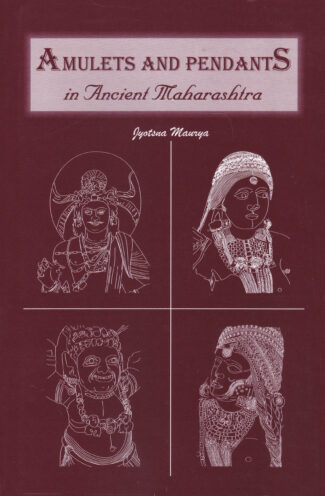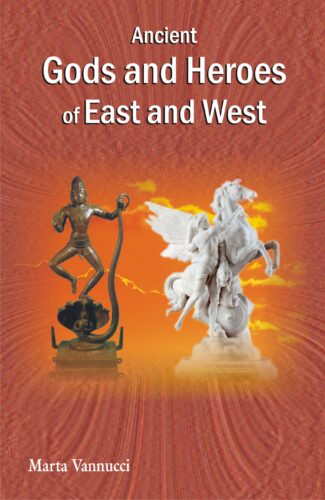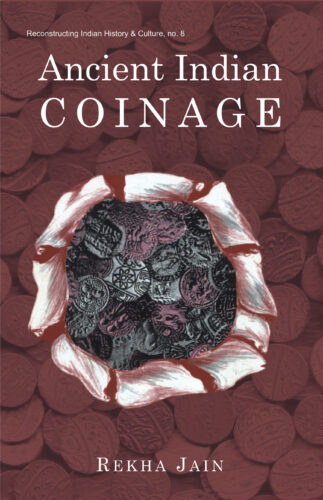Showing 41–50 of 1163 results

The book documents Indias rich tradition of ornamentation as reflected in its numerous and varied collection of amulets and pendants recovered from archaeological excavations in Maharashtra. It examines the different types of amulets and pendants excavated, techniques used in making them, and their parallels in literary and sculptural representations.
The book documents Indias rich tradition of ornamentation as reflected in its numerous and varied collection of amulets and pendants recovered from archaeological excavations in Maharashtra. It studies the significance of these ornaments as a visible expression of the artistic excellence and cultural wealth of the ancient Indian civilisation particularly at the time of the great Mauryan and Satvahana dynasties. Discussing the evolution of these portable charms against their socio-economic and religious background, the authoress examines the different types of amulets and pendants excavated, the techniques used in making them, their parallels in literary and sculptural representations, and Buddhist influence on them. Giving insights into the sources of raw materials used in these charms, she takes up in detail the trade relations of a specific site with other contemporary sites. With a number of figures and maps, the work promises to be useful to both scholars and students of Indology focussing on facets of Indian culture.

It is not just the magnum opus, but a truly monumental effort of a scientist-philosopher who has spent a whole lifetime to formulate a unitive science, wherein all disciplines of human questing could find a common ground a science where modern science and ancient spiritual wisdom could meet and merge like two opposite poles of a magnet. As a direct disciple of one of the great rishis of the modern age, Nataraja Guru discovers this common ground in Brahma-vidya?, which he calls the Integrated Science of the Absolute, and which has, at its base, his Gurus Dars?ana Ma?la?.
A string of hundred Sanskrit verses, composed by the mystic-poet, Narayana Guru (18541928), the Dars?ana Ma?la? is the very epitome of all visions of truth inspired by his remarkable acquisitions of Upanis?adic thought and, yet far more, by his own tapas (mystical discipline). Reproducing these highly significative verses in Roman script, along with English translations, word meanings, and extensive commentaries, Nataraja Guru not only spells out his mentors Visions of the Absolute in contemporary idiom, but also shows how these visions are fully validated by modern science.
Eclectic synthesis of varied scientific disciplines into a systematic whole is not all that Nataraja Guru accomplishes here. Rather, his book (now in third edition) is an attempt to reintroduce Brahma-vidya? as the one Master Science that embraces every branch of science, every human interest.
It is not just the magnum opus, but a truly monumental effort of a scientist-philosopher who has spent a whole lifetime to formulate a unitive science, wherein all disciplines of human questing could find a common ground a science where modern science and ancient spiritual wisdom could meet and merge like two opposite poles of a magnet. As a direct disciple of one of the great rishis of the modern age, Nataraja Guru discovers this common ground in Brahma-vidya, which he calls the Integrated Science of the Absolute, and which has, at its base, his Gurus Dars?ana Mala.
A string of hundred Sanskrit verses, composed by the mystic-poet, Narayana Guru (18541928), the Darsana Mala is the very epitome of all visions of truth inspired by his remarkable acquisitions of Upanisadic thought and, yet far more, by his own tapas (mystical discipline). Reproducing these highly significative verses in Roman script, along with English translations, word meanings, and extensive commentaries, Nataraja Guru not only spells out his mentors Visions of the Absolute in contemporary idiom, but also shows how these visions are fully validated by modern science.
Eclectic synthesis of varied scientific disciplines into a systematic whole is not all that Nataraja Guru accomplishes here. Rather, his book (now in third edition) is an attempt to reintroduce Brahma-vidya as the one Master Science that embraces every branch of science, every human interest.
The book aspires to do for Indian poetics what Hudson’s book, An Introduction to the Study of English Literature did for English literature, though in a totally different manner and style. It provides the student with the essential knowledge about almost all aspects of Indian poetics. Based on the original Sanskrit sources, it presents the necessary information lucidly in precise and clear terms. Each chapter is self-contained and complete in itself, with explanatory notes, and a bibliography of relevant works. The Sanskrit terms used in the text are invariably explained or provided with English equivalents.
For quick reference, “A Glossary of Sanskrit Literary Terms” is given in the Appendices, which contain also “A List of Noted Indian Poeticians (including commentators) and Their Works” and “Notes on Major Texts in Indian Poetics”.
This handy volume, with its unique features, will prove invaluable to those who are going to embark on the study of Indian poetics, especially the ones who have no Sanskrit background. To a devoted student, it will prove a useful companion during his/her further studies.
The book aspires to do for Indian poetics what Hudson’s book, An Introduction to the Study of English Literature did for English literature, though in a totally different manner and style. It provides the student with the essential knowledge about almost all aspects of Indian poetics. Based on the original Sanskrit sources, it presents the necessary information lucidly in precise and clear terms. Each chapter is self-contained and complete in itself, with explanatory notes, and a bibliography of relevant works. The Sanskrit terms used in the text are invariably explained or provided with English equivalents.
For quick reference, “A Glossary of Sanskrit Literary Terms” is given in the Appendices, which contain also “A List of Noted Indian Poeticians (including commentators) and Their Works” and “Notes on Major Texts in Indian Poetics”.
This handy volume, with its unique features, will prove invaluable to those who are going to embark on the study of Indian poetics, especially the ones who have no Sanskrit background. To a devoted student, it will prove a useful companion during his/her further studies.
It is well-known that the Jain tradition has been extremely influential in the development of Indian thought and culture. The Jain tradition teaches that there is an interdependence of perception, knowledge, and conduct unified by an axiomatic principle of non-violence in thought, speech, and action. In this way, non-violence defines the core of the Jain tradition, which has had a profound effect on other dharmic traditions originating in India. Jain Dharma is so significant that in some ways it may be incomplete to attempt to understand other Indian traditions (such as Buddhism or Hinduism) without knowing the basics of the Jain tradition, since these other traditions developed in an ongoing dialogue with the insights and wisdom of Jain respondents and visionaries.
This book enables the reader to enjoy a comprehensive journey into the intricate world of Jain thought and culture in a way that is philosophical in its compelling rationality, deeply spiritual in its revelations, yet accessible in its language. The organization of this book allows the reader to engage in an overview of the central teachings of the Jain tradition, but also to ascertain the profundity of its depths. It can be read with equal efficacy in succession from beginning to end, or pursued by individual topics of interest to the reader. Either strategy will have the same effect: a systematic understanding of what the timeless teachings of Jain thinkers have to say about the universal issues of the human condition – and how we might understand our harmonious relationship with other living entities as a powerful and effective spiritual journey.
Vedanta holds an unparalleled and unique place among the six systems of Indian philosophy. Though the Vedas are the fountainhead of Indian philosophical systems, Vedanta incorporates the philosophical thoughts resplendent in the Upanishads, the Brahmasutras, the Bhagavatgita, and in the commentaries on all these texts.
An Introduction to Vedanta introduces the Vedanta philosophy in brief and talks about its cardinal issues like self-control and the meaning of worship, maya and its gunas, upadhi, the theory of cycle, subtle bodies, the role of meditation, samadhi and its four major obstacles, Brahman realization and the state of a jivanmukta and his relation with Brahman and the world.

This book is an in-depth study of the people of nomadic groups of Central Asia notably, the Greeks, the ancient Iranians and Indo-Aryans of the Indian subcontinent from about 6000 bce to the last millennium bce. It deals with the evolution of cultures, migrations and settlements, myths and legends gods and heroes of the ancient cultures.
This book is a study of the people of nomadic groups or clans of Central Asia from about 6000 bce to the last millennium bce to explore why cultures and history developed the way they did in Central Asia by taking up the Indo-European and other settlements notably, the Greeks, the ancient Iranians and Indo-aryans of the Indian subcontinent for in-depth study. It deals with the quest for knowledge which led to evolution of cultures from simple primitive life to a society complex in structure, from philosophy to religion. The study of gods and heroes examines stories relating to migration and settlements and the geography of ancient civilizations. It is in this setting that their unique philosophies and religious beliefs flourished, giving rise to belief in numerous gods and heroes. It discusses the myths and legends of the ancient cultures, highlighting names, deeds and events relating to honoured gods and much-praised heroes. Dr Marta Vannucci significantly concludes that both Indo-aryan and Indo-Iranian people had been able to maintain their traditional customs and habits backed by technical developments up to the last centuries bce. Throughout, she bases her observations on reliable information provided by archaeology substantiated by oral and written traditions of Central Asia, Greece and Rome. The volume will be invaluable to scholars of history, anthropology and archaeology who are keen to systematically unravel the obscure origins of the great human civilizational march.

Re-dating and re-interpreting Manusmriti, possibly the oldest law work in the world, the book deals with aspects of Ancient India, including Aryan society and culture, castes and guilds, use of technology and related practices in the Indus Valley Civilisation. It also provides a look at other ancient law codes of the then known world and then compares them with the Manusmriti.
This is a fresh look at the history of Ancient India, centering on the Law Code of Manu (Manusmriti / Manu Dharmashastra), and its relationship to Rigveda and its possible relationship to the Indus/Harappan Civilisation of 4000 to 5000 years ago. It also throws light on Aryan society and culture, castes and guilds, use of technology and related practices in the Indus Valley Civilisation.
Dr. Charles Naegele, a practicing lawyer in Silicon Valley, California, USA, and a lifelong student of classical Indian knowledge, has written a work that will be certain to stir up controversy regarding the re-dating of the Law Code of Manu and the well-documented research concerning almost no possibility of Aryan Invasion Theory and the numerous similarities between the text of the Law Code of Manu and the archeological finds from the Indus/Harappan Civilisation.
Scholars and history buffs, as well as everyone who is proud of Indian heritage will enjoy not only this work, but also his future works.

This book studies ancient Indias monetary economy in terms of its coinage through six successive periods from the janapadas to the pre-medieval. It establish linkages between the ancient coins and their references in ancient texts.
Money is unmistakably a landmark invention considering its indispensable role in economics and, more specially, in the commercial sphere of mans existence anywhere in the world. However, we have yet to have final answers to some of the fundamental questions: When, where, and how was money shaped as coins or as pieces of stamped metal first introduced to human civilization? Its genesis in India is traced back to the sixth century bc: during the second urban revolution, when coins came to be manufactured here independently, indigenously. Analysing in depth an astonishing mass of numismatic and kindred data, published in different catalogues, archaeological reports, journals and elsewhere, this book investigates the evolution of ancient Indias money economy: in terms of its coinage, through six successive periods: janapada, Maurya, post-Maurya, Gupta, post-Gupta, and pre-medieval which, in their togetherness, span nearly two millennia. Covering the entire subcontinental sprawl, Dr. Jain considers the whole variety of coins: local, universal standard, and even foreign, with meticulous descriptions of coin types, symbols, legends, fabric and metrology. In her thematic effort to reconstruct the history of ancient Indian coinage (and, thus, money economy), from its first beginnings in high antiquity to about the twelth century ad, the author has drawn on wide-ranging primary and secondary sources. And has also tried to establish linkages between different ancient coins and their references/descriptions in Vedic/Buddhist/Jaina texts, Paninis Ashtadhyayi, Kautilyas Arthashastra, epical literature, Dharmashastras, foreigners travelogues, old-world mathematical treatises, and numerous contemporary inscriptions, among others writings.

This book studies ancient Indias monetary economy in terms of its coinage through six successive periods from the janapadas to the pre-medieval. It establish linkages between the ancient coins and their references in ancient texts.
Money is unmistakably a landmark invention considering its indispensable role in economics and, more specially, in the commercial sphere of mans existence anywhere in the world. However, we have yet to have final answers to some of the fundamental questions: When, where, and how was money shaped as coins or as pieces of stamped metal first introduced to human civilization? Its genesis in India is traced back to the sixth century bc: during the second urban revolution, when coins came to be manufactured here independently, indigenously. Analysing in depth an astonishing mass of numismatic and kindred data, published in different catalogues, archaeological reports, journals and elsewhere, this book investigates the evolution of ancient Indias money economy: in terms of its coinage, through six successive periods: janapada, Maurya, post-Maurya, Gupta, post-Gupta, and pre-medieval which, in their togetherness, span nearly two millennia. Covering the entire subcontinental sprawl, Dr. Jain considers the whole variety of coins: local, universal standard, and even foreign, with meticulous descriptions of coin types, symbols, legends, fabric and metrology. In her thematic effort to reconstruct the history of ancient Indian coinage (and, thus, money economy), from its first beginnings in high antiquity to about the twelth century ad, the author has drawn on wide-ranging primary and secondary sources. And has also tried to establish linkages between different ancient coins and their references/descriptions in Vedic/Buddhist/Jaina texts, Paninis Ashtadhyayi, Kautilyas Arthashastra, epical literature, Dharmashastras, foreigners travelogues, old-world mathematical treatises, and numerous contemporary inscriptions, among others writings.
| There are no products |